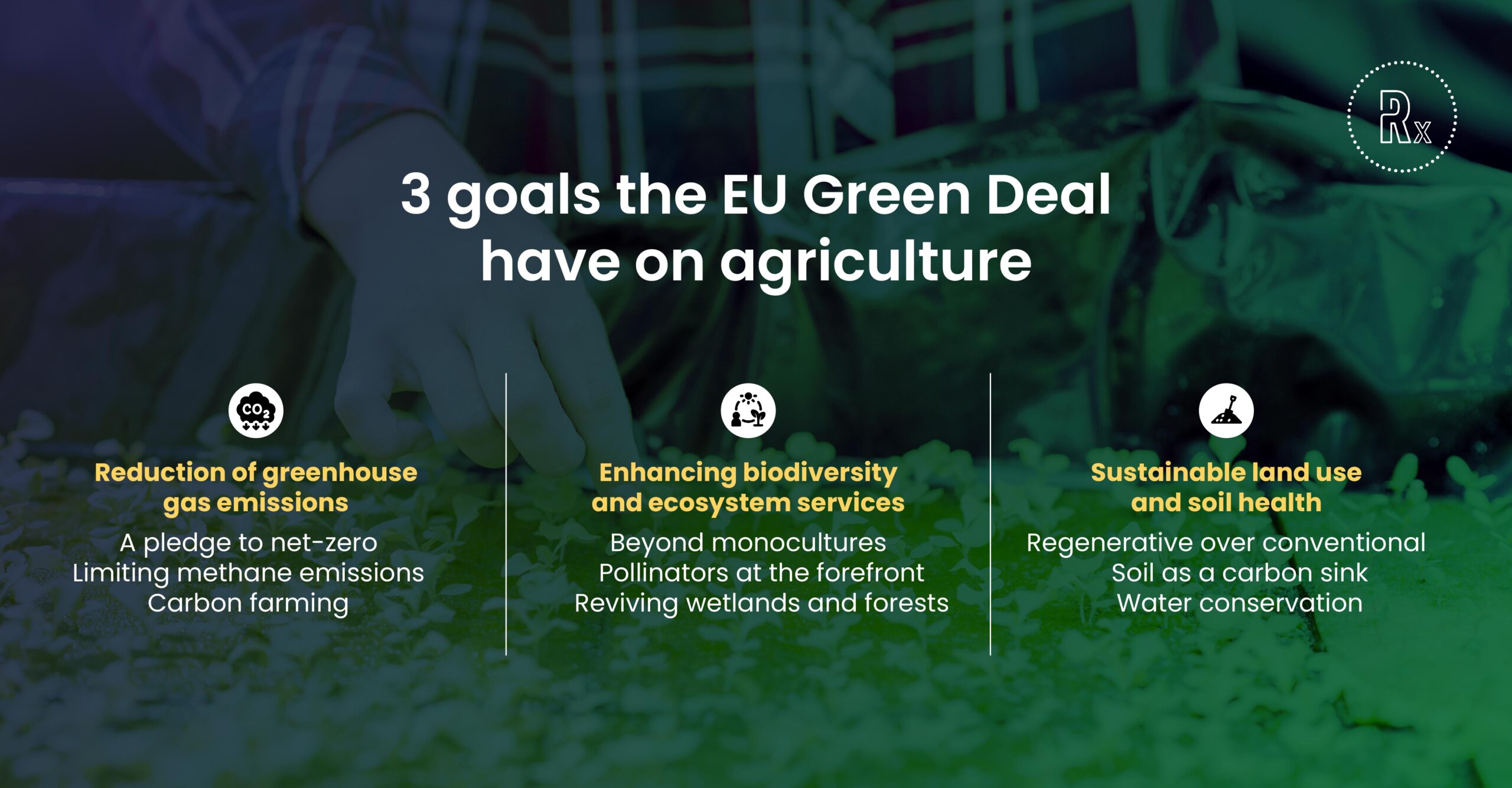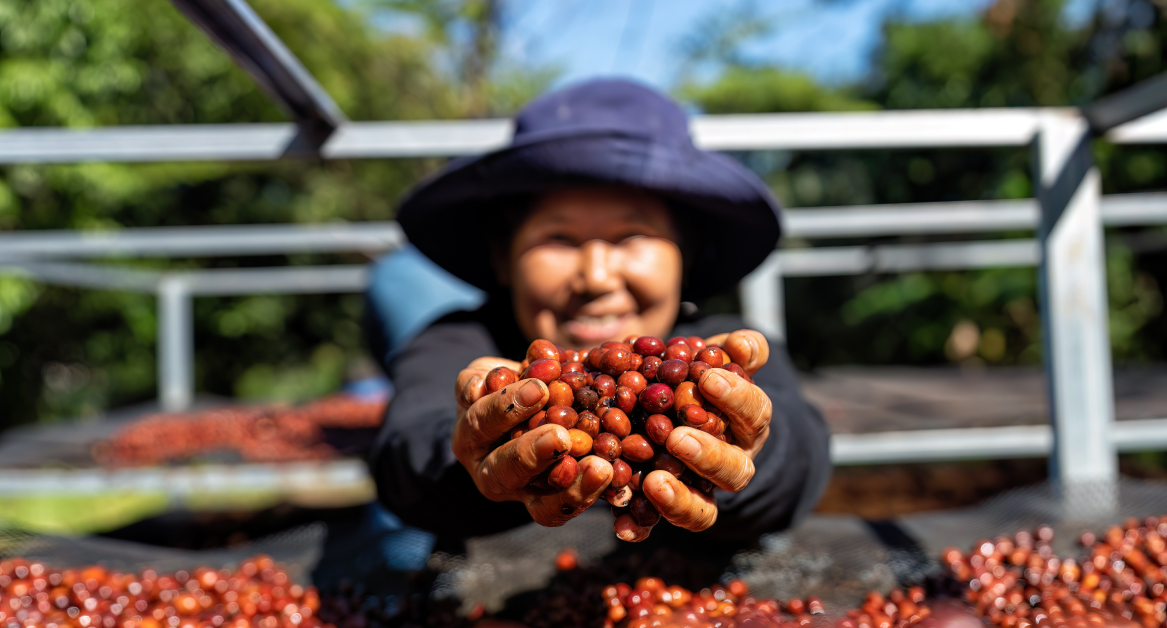The Green Deal is an ambitious set of proposals unveiled by the European Union in late 2019 with the goal of making Europe ‘the first climate-neutral continent’ by 2050. A wide range of sectors will need to take action and implement policy change if this target is going to be achieved, including agriculture – one industry that has a particularly large impact on both the climate and the environment.
Dive in to decode the EU Green Deal’s aspirations for agriculture and how it promises to reshape the future of food production, for the better.
The EU Green Deal’s goals for agriculture
Agriculture accounts for nearly a quarter of Europe’s greenhouse gas emissions. Simultaneously, it offers unparalleled opportunities to mitigate climate change through sustainable and regenerative practices.
Enter the EU Green Deal – an ambitious roadmap laid out by the European Union aiming to transform every sector, with agriculture at its forefront. But how does this Deal hope to revolutionize farming and food security in the EU? Let’s explore.

Reduction of greenhouse gas emissions
Central to the European Green Deal is the pledge to make the European continent climate-neutral by 2050. this translates to a net-zero carbon footprint for its agriculture sector, requiring dramatic changes in current farming and land management practices.
Limiting methane emissions:
Livestock farming, particularly cattle, is a significant contributor to methane emissions – a greenhouse gas with far more warming potential than carbon dioxide. New mandates under the Green Deal push for dietary shifts in crop production, livestock management reforms, and the adoption of technologies to reduce these emissions.
Carbon farming:
A third sustainable agriculture alternative gaining traction is carbon farming, where practices like agroforestry, intercropping, and cover cropping are used to capture more carbon in the soil. Companies like RegenX are pivotal in this movement, bridging the gap between regenerative farmers and global food buyers. With the support of the EU Green Deal, the stage is set for a larger transition towards carbon-positive farming.
Enhancing biodiversity and ecosystem services
Monocultures, the practice of growing a single crop over an expansive area agricultural land, is a typical modern farming method. While economically attractive, it’s environmentally unsustainable. The Green Deal aims to reduce these monocultures by promoting organic production and crop diversification, benefiting both the soil and the ecosystem.
Pollinators at the forefront:
Biodiversity isn’t just about flora; it’s equally about fauna. Pollinators like bees play a crucial role in agricultural productivity and the farming ecosystem. Their declining numbers are alarming. The Green Deal recognizes this and introduces measures to curtail the use of pesticides that threaten these species, aiming for a 50% reduction by 2030.
Reviving wetlands and forests:
Wetlands and forests act as natural buffers, aiding in flood control, and serving as carbon sinks. Restoring these other natural resources and habitats is a key goal under the Green Deal, fostering a richer biodiversity and human health and strengthening ecosystem services.
Sustainable land use and soil health
Conventional agriculture, with its heavy reliance on chemical fertilizers, has led to soil degradation. RegenX‘s approach, endorsing regenerative practices, mirrors the EU Green Deal’s objective to switch to more sustainable farming methods that enhance soil health and reduce the chemical fertilisers input.
Soil as a carbon sink:
Healthy soils are not only productive but also serve as significant carbon sinks. By promoting practices that increase organic matter in the soil, the Green Deal aims to harness this carbon-capturing potential, mitigating the impacts of climate change.
Water conservation:
Water, a vital resource for agriculture, is under threat due to changing climate patterns and overuse. The EU Green Deal emphasizes efficient irrigation methods, rainwater harvesting, and sustainable water management practices to ensure that Europe’s farms remain productive, even under changing climatic conditions and resource management.
In essence, the EU Green Deal is not just a set of regulations; it’s a vision. A vision of a continent where food is grown sustainably, where biodiversity thrives, and where farming becomes a solution to the climate crisis, rather than a contributor.
Policy instruments and initiatives
Under the EU Green Deal, several critical mechanisms aim to drive the food and agriculture sector further towards more sustainable horizons.
Common agricultural policy (CAP) and the green deal
The Common Agricultural Policy, a longstanding cornerstone of EU agriculture, is undergoing significant revisions to align with the Green Deal’s objectives. CAP will play a pivotal role in directing funds towards green initiatives, ensuring farmers receive the support they need to transition to more more sustainable production practices.
CAP’s “eco-schemes” are set to offer financial incentives to farmers who adopt environmentally-friendly agricultural practices, reducing food waste. This provides a tangible reward system, pushing the agriculture sector towards a greener future.
Farm-to-fork strategy
The Farm to Fork Strategy, under the umbrella of the Green Deal, aims to transform the way Europe produces, processes, and consumes its own sustainable food system. By 2030, the strategy targets a reduction of chemical pesticides by 50%, and fertilizers by 20%, setting clear benchmarks for the agricultural sector’s evolution.
Under this strategy, the EU aspires for 25% of its total farmland to be under organic farming by 2030. This not only benefits the environment but also boosts the health of European consumers, aligning organic agriculture with the continent’s biodiversity strategy and broader health and well-being objectives.
Rural development programs
Beyond the big farms and sprawling fields lies the heart of Europe’s agriculture: its rural communities. Rural Development Programs focus on improving the quality of life in these rural areas, emphasizing infrastructure, education, and sustainability.
By integrating tourism with agriculture, its environmental and climate footprint these programs aim to down agricultural emissions, diversify income sources for farmers and provide an authentic, enriching experience for tourists. Agri-tourism showcases the value of sustainable farming practices to a broader audience.
Eu deforestation regulations
A significant portion of deforestation globally can be attributed to agricultural expansion. The EU, as a major consumer of agricultural products, is taking responsibility by implementing the EU deforestation regulations or EUDR that curb imports linked to deforestation.
Transparency is at the heart of these regulations. Tools and frameworks are being developed to track the origin of imported agricultural goods, ensuring they meet the EU’s sustainability standards
Cultivating a greener future
With policy instruments that stretch from the soil to the supper table, the Green Deal offers a comprehensive blueprint for an eco-conscious European agriculture sector:
In this sustainable campaign, RegenX fills a crucial gap in food system, connecting sustainable farmers with conscious buyers, less food waste and ensuring that the transition to green agriculture is both beneficial and feasible for all involved. With traceable ingredients right from Regen Aug farms, we offer businesses a unique opportunity to align their supply chains with the EU’s stringent sustainability standards.



